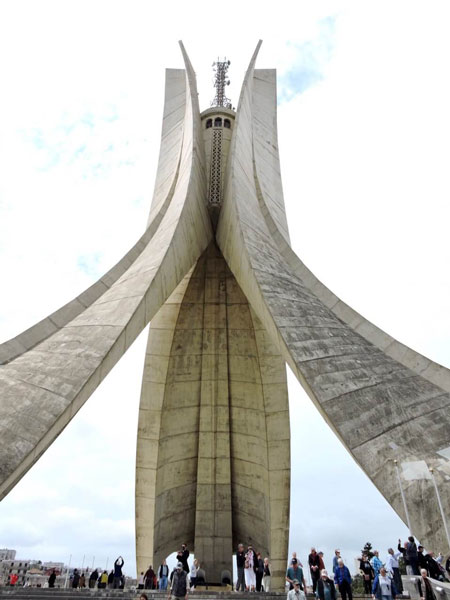
Algiers, Algeria
Algiers, Algeria
Docked at Port Algiers
Latitude 36.78 Degrees North and
Longitude 3.06 Degrees East
April 27th, 2018
Weather: Sunny With Light Breeze and High of 73 Degrees With Low Humidity
Author: Don
Today we visited Algiers, capital of Algeria on the north of the African Continent. It was a bit of a disappointment. Our Cruise Director's and Shore Excursions Director's port talks had warned us it would not be very glamorous, and it wasn't. For one thing, the government would not let anyone go ashore outside of a formal shore excursion. To us, Algeria seemed to be another apparently depressed strictly-Muslim country with only stern-looking men to be seen on the streets during midday. (We were told that only men go to the noon prayer at the mosques, but the women would fill the streets later in the afternoon for shopping.) Our tour buses had a police escort at all times. The metropolitan area's population is a densely packed 5 million people who speak mostly French and their own unique, local Arabic dialect. Very few people here speak any English.
Algiers likes to call itself the “white city” because most of the buildings are painted white. There was evidence of a lot of external building maintenance in progress, but the work must be going very slowly because many of the buildings we saw were in need of repair and paint. Most of the buildings in Algiers were built by the French during French possession of Algeria, so they have a distinctively French appearance architecturally. But to us, it looked as though they had not been given much care since Algeria won its independence from France in the 1960s (after a long and bloody fight). We were told that even the fabled Casbah was now essentially just a run down and smelly old neighborhood. (Donkeys are used for hauling garbage there.)
Tourism as an industry is relatively new to Algeria. From early 1990s to the early 2000s, a civil war between the government and armed extreme religious conservatives raged sporadically.
The largest part of Algeria is the Sahara (which means “desert” in the local language), but by far most of the people live along the Mediterranean coast.
Our tour today took us through much of Algiers and to the Algeria Monument of Martyrs, which honors the thousands who died during the Algerian war for independence. It is an impressive 302-feet tall structure built atop a hill in Algiers. It has three large soldier statues, each representing a stage in Algeria's struggle. Algerians are justly very proud of it.
Our guide, Aladdin, was an intelligent and articulate young Algerian man (with a wife and brand new baby daughter) who was proud of his city and country, but nevertheless, was emigrating to Canada within the next several weeks.
-
 A Main Street In AlgiersA Main Street In Algiers
A Main Street In AlgiersA Main Street In Algiers -
 Algier's Botanical GardensAlgier's Botanical Gardens
Algier's Botanical GardensAlgier's Botanical Gardens -
 Algiers And Our Ship Seen From The Martyr's MemorialAlgiers And Our Ship Seen From The Martyr's Memorial
Algiers And Our Ship Seen From The Martyr's MemorialAlgiers And Our Ship Seen From The Martyr's Memorial -
 Algiers Street With French-Era BuildingsAlgiers Street With French-Era Buildings
Algiers Street With French-Era BuildingsAlgiers Street With French-Era Buildings -
 Ancient Ruins Discovered During Underground Rail ConstructionAncient Ruins Discovered During Underground Rail Construction
Ancient Ruins Discovered During Underground Rail ConstructionAncient Ruins Discovered During Underground Rail Construction -
 Basilica Notre-Dame D'Afrique - Built 1872Basilica Notre-Dame D'Afrique - Built 1872
Basilica Notre-Dame D'Afrique - Built 1872Basilica Notre-Dame D'Afrique - Built 1872 -
 Debbie At (Temporarily Extinguished) Eternal FlameDebbie At (Temporarily Extinguished) Eternal Flame
Debbie At (Temporarily Extinguished) Eternal FlameDebbie At (Temporarily Extinguished) Eternal Flame -
 Guard At Base of Algeria's Martyr's MemorialGuard At Base of Algeria's Martyr's Memorial
Guard At Base of Algeria's Martyr's MemorialGuard At Base of Algeria's Martyr's Memorial -
 Mural In AlgiersMural In Algiers
Mural In AlgiersMural In Algiers -
 National Martyrs Monument In AlgiersNational Martyrs Monument In Algiers
National Martyrs Monument In AlgiersNational Martyrs Monument In Algiers -
 Nice Tile Mosaics On Wall Around The HarborNice Tile Mosaics On Wall Around The Harbor
Nice Tile Mosaics On Wall Around The HarborNice Tile Mosaics On Wall Around The Harbor -
 Parking Lot Decorated With Indiginous People's Rug PatternsParking Lot Decorated With Indiginous People's Rug Patterns
Parking Lot Decorated With Indiginous People's Rug PatternsParking Lot Decorated With Indiginous People's Rug Patterns -
 Part Of Our Police EscortPart Of Our Police Escort
Part Of Our Police EscortPart Of Our Police Escort -
 Soldier Representing Early Stage Of War For Independence From FranceSoldier Representing Early Stage Of War For Independence From France
Soldier Representing Early Stage Of War For Independence From FranceSoldier Representing Early Stage Of War For Independence From France -
 Standing At Algiers' Martyr's MonumentStanding At Algiers' Martyr's Monument
Standing At Algiers' Martyr's MonumentStanding At Algiers' Martyr's Monument -
 Statue Of Early Algerian RulerStatue Of Early Algerian Ruler
Statue Of Early Algerian RulerStatue Of Early Algerian Ruler -
 Statue of Emir Abdelkader, Military Leader Against French Colonial InvasionStatue of Emir Abdelkader, Military Leader Against French Colonial Invasion
Statue of Emir Abdelkader, Military Leader Against French Colonial InvasionStatue of Emir Abdelkader, Military Leader Against French Colonial Invasion -
 The Maqam Echahid (Martyr's Memorial)The Maqam Echahid (Martyr's Memorial)
The Maqam Echahid (Martyr's Memorial)The Maqam Echahid (Martyr's Memorial) -
 Typical French-Era Architecture In DisrepairTypical French-Era Architecture In Disrepair
Typical French-Era Architecture In DisrepairTypical French-Era Architecture In Disrepair

